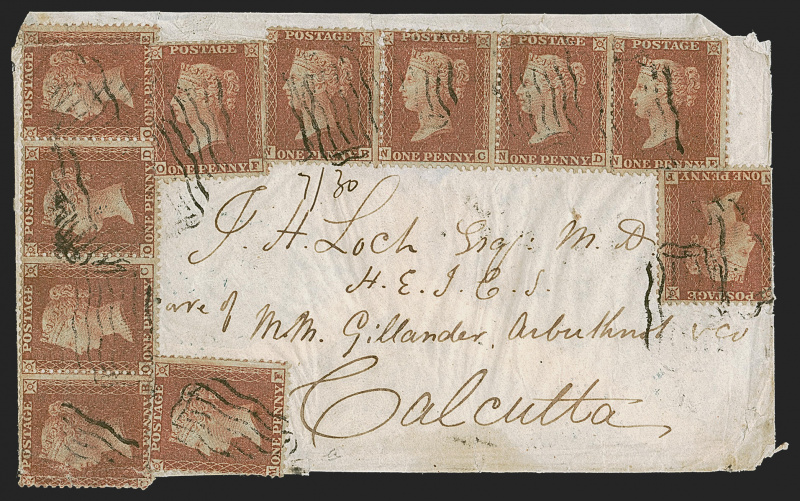Datei:1855-Malta-Calcutta.jpg

MALTA, Great Britain Used in Malta, 1855, 1p Red Brown, Die II, Perf 14 (A2; SG Z2). Horizontal strip of four, strip of three, and four singles, all tied or cancelled by the Malta wavy-line boxed cancel on 1855 cover originating in the Crimea and addressed to J. H. Loch in Calcutta, India, indistinct Malta despatch datestamp on back, blue Alexandria Jun. 3 transit and "Calcutta Steam Letter Bearing" "8" arrival backstamps, docketing on back "Received Jul. 8/55 Nongong", accompanied by original letter enclosure datelined "Palace Hospital, Scutari, 29th April 1855", cover slightly refolded at top to accommodate placement of stamps which have been affected by placement, some minor edge wear, enclosed letter legible but with splits due to corrosive ink used FINE. A REMARKABLE COVER FRANKED WITH ELEVEN GREAT BRITAIN ONE-PENNY STAMPS USED IN MALTA WITH THE RARE WAVY-LINE CANCEL APPLIED IN TRANSIT FROM THE CRIMEA TO INDIA. The accompanying letter was written by Dr. F. de Caumont while at the Scutari Hospital, a British military hospital. He wrote the letter to a colleague in India describing the conditions in the Crimea, treatment of a range of diseases, and a wound inflicted on a solider. The hospital was a converted barracks and not designed to cope with the thousands of sick and injured soldiers who were brought in for medical care. The Scutari hospital in particular was one of the locations that prompted Florence Nightingale to advocate for better treatment of wounded and sick soldiers. To put it into perspective, during the winter of 1854, more than 4,000 soldiers died at Scutari. Reports suggest the death toll from disease and sickness was more than ten times that of battle related injuries. The boxed wavy-line cancel of Malta was in use specifically for transit mail from covers originating in the Crimea, the Black Sea Fleet or from officers in Constantinople. This mail was sent via Valletta where the postmark was applied. According to Parmenter-Gordon, the cancel is only known used between Apr. 23, 1855, and Sep. 3, 1856 and is prior to the period where Great Britain stamps were sold at Maltese post offices. Parmenter-Gordon assigns a rarity factor "H" to covers indicating"very few exist" and provides a price range from ÂŁ9,000 to ÂŁ22,000. From the Magnolia collection. Ex Bollen and "Dubois". Illustrated in Parmenter-Gordon p. 1/12
Auktion
- Robert A Siegel USA 27.6.23 Erlös: 5500.- USD
Dateiversionen
Klicke auf einen Zeitpunkt, um diese Version zu laden.
| Version vom | Vorschaubild | Masse | Benutzer | Kommentar | |
|---|---|---|---|---|---|
| aktuell | 17:32, 8. Aug. 2023 |  | 1'912 à 1'198 (637 KB) | WikiAdmin (Diskussion | BeitrÀge) | MALTA, Great Britain Used in Malta, 1855, 1p Red Brown, Die II, Perf 14 (A2; SG Z2). Horizontal strip of four, strip of three, and four singles, all tied or cancelled by the Malta wavy-line boxed cancel on 1855 cover originating in the Crimea and addre⊠|
- Du kannst diese Datei nicht ĂŒberschreiben.
Dateiverwendung
Die folgende Seite verwendet diese Datei: